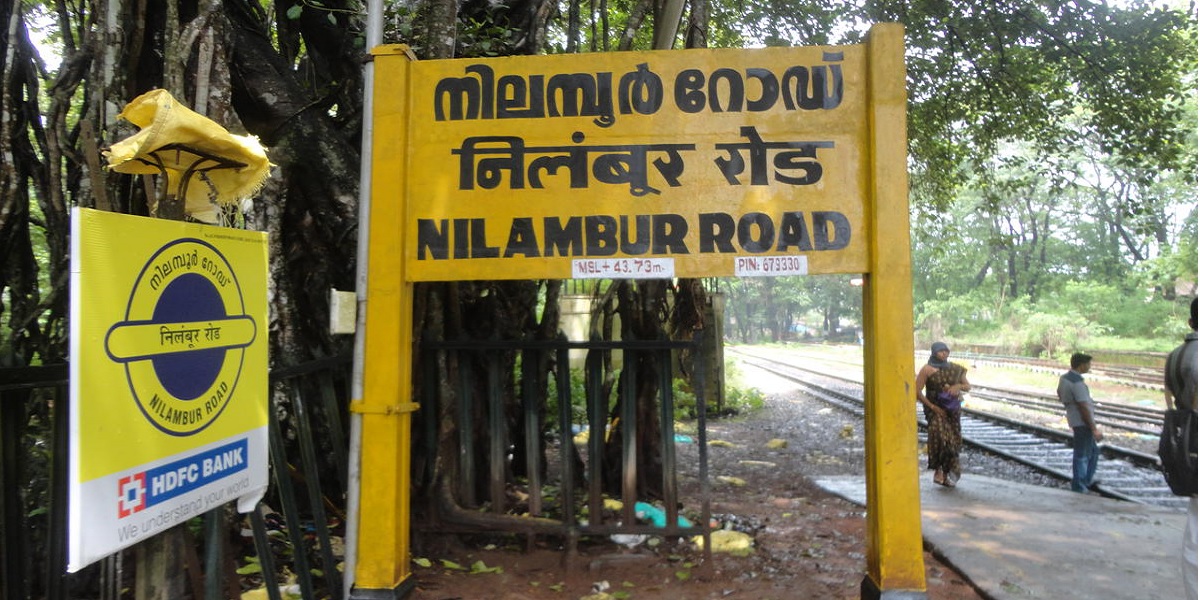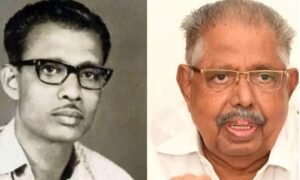Long before the names Anvar and Aryadan became synonymous with Nilambur, the constituency belonged to Kunhali and his comrades. This land of teakwood trees, has witnessed sagas of political passion and violence. Why the upcoming bypoll is important for both Congress and CPI(M)?
Published Jan 26, 2025 | 9:00 AM ⚊ Updated Jan 26, 2025 | 9:00 AM

Regardless of political equations, Nilambur deserves a strong and resolute voice in the Assembly. (img-India Rail Info)
Years spent in the Indian Army made Karikadan Kunhali fearless. After World War II, he returned home and dedicated his life to social causes.
As a member of the Communist Party of India and later CPI(M), he was one of the towering leaders of the Left movement in Kerala’s Eranad region, now known as Malabar.
Born in Kondotty, then a part of the Madras Presidency, in 1924, Comrade Kunhali — as he was known in party circles — made Nilambur his home ground, and represented the constituency twice in the state Assembly.
The segment, on the banks of the River Chaliyar, had been politically tense with the Congress vying to end the CPI(M)’s dominance. Kunhali, however, did not expect it to lead to bloodshed.
A road separated the Congress and CPI(M) offices at Chullivodu in Nilambur in the Malappuram district. The night of 26 July 1969 was particularly silent in Nilambur, lying in the shadow of the Western Ghats.
A flash of light from across the road intruded into and lit up the CPI(M) office temporarily. Kunhali was then walking towards his vehicle.
Unknown to him, there were people on the other side of the road who had different plans.
Soon after Kunhali sought to know who was flashing the torch, a blinding light bathed the MLA. Even as his eyes tried to accustom themselves to the sudden brightness, a gunshot shattered the stillness of the tranquil night.
Moments after the gunshot rang through the night, party comrades found Kunhali down, a stream of blood rapidly spreading into a pool. Two days later on 28 July, he died in a hospital bed.
Kunhali’s biographer Basheer Chungathara later recorded him as the first sitting MLA to be assassinated in India.
Aryadan Muhammed was in the shadows when Kunhali represented Nilambur, the land of mighty teakwood trees. PV Anwar had just turned one when a bullet downed Kunhali.

K Kunhali (L) and Aryadan Mohammed.
In the years that followed, Nilambur witnessed sagas of political passion and violence. Muhammed and later Anwar became synonymous with the land near the Nilgiris range of the Western Ghats.
The constituency is now readying itself for yet another by-election following Anvar’s 13 January resignation and the merging of his newly founded Democratic Movement of Kerala with the Trinamool Congress.
Anvar, who was with LDF, resigned to expose Pinarayism, a term he had coined to describe Chief Minister Pinarayi Vijayan’s autocratic, and undemocratic ways, unbecoming of a Communist leader.
For a section of the media, he is the Nilambur Tusker. His clout in the constituency will be put to the test in the bypoll. He had won the constituency (Earlier Eranad constituency) only with Left support.
To understand the political heartbeat of this land, it is necessary to take a relook at Kunhali, his murder, the Congress’s first victory, and the many polls that followed.
This is the story of Nilambur’s thrilling political legacy.
Though the offices of the Communist Party and the Congress stared at each other from either side of the road amid growing tension, there were no overt signs of conflict.
On 26 July 1968, however, a rumour said the Communist party office would be attacked by its political rival. Party workers gathered at the office to defend the property. Congress workers also gathered in strength.
The development was the offshoot of a dispute over the INTUC’s opposition to certain workers and landlords cooperating with the AITUC.
As rumors spread of potential violence against party workers, tensions escalated. By 10 pm on 26 July 1968, a decision was made to disperse.
Moments later, the sound of the gunshot rolled away into the still night, leaving Kunhali injured. The blinding light, it was learnt later, was meant to identify the MLA.
Initially, it was thought that the shot was made from the Congress office above but later doctors, who treated Kunhali, said that it came from below.
In his death statement, Kunhali claimed Muhammed and others were behind the shooting. Though Muhammed was kept in remand for a year, he was acquitted due to a lack of evidence. It was argued in the court that he was then in the office, and not at the ground level.
Four months after Kunhali’s death, C Achutha Menon of the CPI became the chief minister. The case took a new turn when, in 1971, when a Congress sympathiser Gopalan, believed to be responsible for the shooting, was killed by party workers.
After the Communist Party split in 1964, some members were branded as Chinese spies and incarcerated. Kunhali was one among them.
During his time in jail in 1965, Kunhali contested from Eranad and became an MLA. Though the CPI(M) was the largest faction, the governor refused to invite the party to form a government, and instead, expelled them.
Kunhali was re-elected in 1967. Following his death, a by-election was held in the constituency.
Aryadan Muhammed’s political journey in Nilambur began in 1977, marking the start of a remarkable career. He won the Assembly seat for the first time in 1977 and went on to establish his dominance in the constituency.
Though Left-backed independent TK Hamsa narrowly defeated him in the 1982 Assembly elections, Muhammed made a strong comeback in 1987 by defeating Devadas Pottakkad.
From 1987 onward, Muhammed’s connection with Nilambur’s electorate grew stronger. He served as the Minister for Electricity and Transport in the Oommen Chandy government. He represented Nilambur until 2016, after securing his eighth victory in the 2011 Assembly elections.
Earlier in his career, Muhammed held the position of Minister for Labour and Forests in the EK Nayanar cabinet from January 1980 to October 1981. Later, he served as the Minister for Labour and Tourism under AK Antony’s leadership between April 1995 and May 1996.
During Chandy’s first term as chief minister (2004–2006), Muhammed was entrusted with the electricity portfolio in September 2004. In Chandy’s second term (2011–2016), Muhammed again held the power and transport portfolios.
His ability to navigate the complex political landscape and connect with the people ensured his enduring success. His tenure was not without controversy—most notably, allegations from the CPI(M) linking him to Kunhali’s assassination.
Despite such accusations, Muhammed solidified his position as one of the most influential leaders in Nilambur.
In 2016, Aryadan Muhammed retired from active politics and handed the mantle to his son, Aryadan Shoukath, who contested as the Congress candidate. However, the political tide had shifted in Nilambur.

PV Anvar, MLA. (PV Anvar/Facebook)
Anvar, an independent candidate backed by the Left, defeated Shoukath, breaking the Congress’s long-standing hold over the constituency.
Nilambur’s political narrative has always been dynamic. It began in 1965 when the constituency was formed by carving it from Manjeri. Kunhali became its first MLA, and he retained the seat in 1967. Both times, Muhammed was his nearest rival.
However, Kunhali’s assassination led to the first by-election in 1970. Despite a sympathy wave favouring the CPI(M), Congress candidate MP Gangadharan secured the party’s first victory in Nilambur.
The second by-election in 1980 saw Muhammed contesting as a candidate for Congress (United), defeating MR Chandran of Congress (Indira). This election followed a dramatic resignation by C Haridas, who stepped down just 10 days after being elected to make way for Muhammed.
Over the years, Nilambur has seen intense political battles, shaped by shifting alliances and changing voter preferences, culminating in Anvar’s victory in 2016, symbolising a new chapter for the constituency.
Anvar’s entry into the Trinamool Congress (TMC) was a surprise to political Kerala, and many expected that he might contest from Nilambur as a TMC candidate.
However, true to his dramatic political style, Anvar sprang a surprise by suggesting Malappuram DCC president VS Joy as the UDF candidate for the upcoming bypolls.
This move has narrowed the contest to a face-off between the Congress and the CPI(M). Shoukath’s statement that he would not respond to Anvar’s jibes suggests that the Congress has reached an internal consensus.
Anvar, who had wrested Nilambur from the Congress, is now effectively handing it back. His recommendation of a Congress candidate has raised eyebrows, hinting at a strategy to keep his political rival, Shoukath, out of the race.
Shoukath, however, has chosen to sidestep Anvar’s provocations.
The CPI(M) appears unfazed, with district leaders asserting that Anvar lacks support in Nilambur and has failed to maintain a political base. CPI(M) state secretary MV Govindan has even suggested that Anvar’s return to the UDF is inevitable.
While UDF leaders insist that the final decision on the candidate lies with Congress and the coalition, Anvar’s unexpected endorsement of Joy has already stirred the political waters. Talks and deliberations are expected to intensify in the coming days.
(Edited by Majnu Babu).
